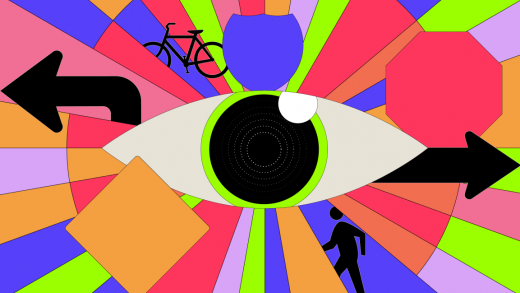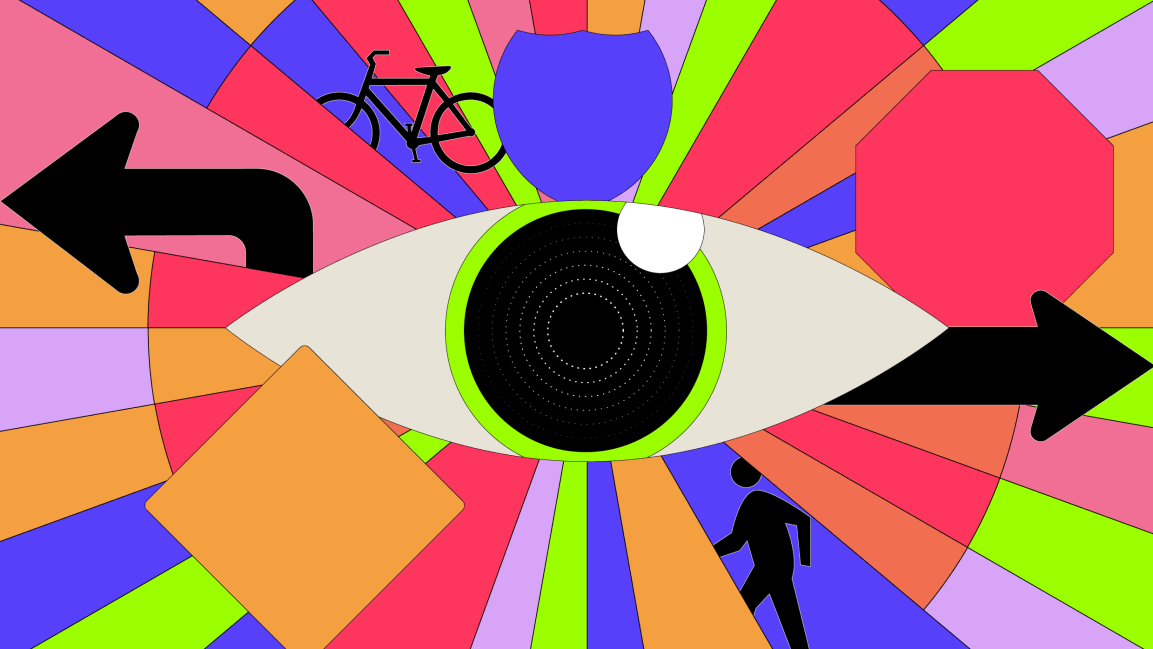This urban planner created a new metric to find a city’s most frightening intersections
That metric also limits how we even begin to measure the concept of “safety.” A map of crash hot spots doesn’t tell us what routes people avoid entirely because they don’t feel safe on that road. It also means a safety measure might be put in place only after a certain number of crashes, so there’s a “literal human cost” to the way we measure or plan for safety, Ryerson says. Instead, she created another metric, based on biometric data that can identify dangerous or challenging parts of urban infrastructure before a crash ever occurs.
For her study, a group of cyclists biked around Philadelphia wearing eye-tracking glasses and a gyroscope that collected data on when and where they moved their eyes, and how often and at what points in their ride they swiveled their heads around. Those movements indicated the cognitive workload and stress levels the cyclists felt as they traveled through different types of road infrastructure, like riding in a protected bike lane for one stretch, and then in a “mixing zone”—an area where there is no physical separation between bikes and cars—the next.
The researchers tracked four workload indicators: gaze velocity (the amount of eye movement per second) and position; vertical and lateral angles; and vertical and lateral gyroscope angles, which correlate with cyclists turning their head to check over their shoulder or tilting their head up and down to look for potholes or to read road signs.
“When cognitive workload is very high, the chance that you make an error is much, much larger than when your cognitive workload is low,” says Ryerson, also the lead author of the study, published recently in the journal Accident Analysis & Prevention. If a road design already causes a high cognitive workload and then something unexpected happens—a pedestrian stepping off the curb or a driver veering into the bike lane—it becomes harder for a cyclist to process that new information and react in time.
Measuring cognitive workload based on eye and head measurements isn’t new. It’s used to set policies about how many aircrafts an air traffic controller can manage at once, and speed limits around curves, based on how far the driver can see ahead of them. For anyone who has biked around a city, it’s obvious which stretches of road spike your stress levels and require more focus, compared to areas like a protected bike lane, where there’s relatively little fear of a crash. Ryerson’s findings based on biometric data put concrete evidence behind those feelings.
In that way, her findings aren’t that surprising. “I’m not the first person to say mixing zones are less safe [than protected bike lanes], and we know even from crash data that mixing zones are where more crashes happen compared to protected zones,” she says. “But what I can now say is: Hey, I have four new variables that are continuous and human focused, that can be used to measure safety rather than waiting for someone to die.”
Although the fact that cyclists experienced higher stress and cognitive workload in less-protected areas of the road wasn’t shocking, there was one surprising find: No matter their experience level, every cyclist had their highest stress moments in the same spots. The researchers found this by normalizing an individual’s stress and workload levels to their own baseline, ??rather than looking across all 39 participants and pulling out the highest measurements. “Even if I, for example, am a ‘nervous, look-everywhere cyclist,’ and you are a ‘confident, looking-straight-ahead cyclist,’ we both had our highest stress moments in exactly the same spaces,” Ryerson says. “That finding alone says it’s the infrastructure that is eliciting these responses.”
Now that Ryerson has established these new metrics to measure safety, she’s using them to do a before-and-after comparison of a recently installed bike lane in Philly, to see whether the infrastructure change had any effect on cyclist stress and cognitive workload. She hopes this helps change the definition of safety away from crashes and deaths to being about stress, workload, and how pedestrians and cyclists feel. “In doing so,” she says, “I think we’ll get a more comprehensive view, a more human-centered view, of safety in our cities.”
(51)



